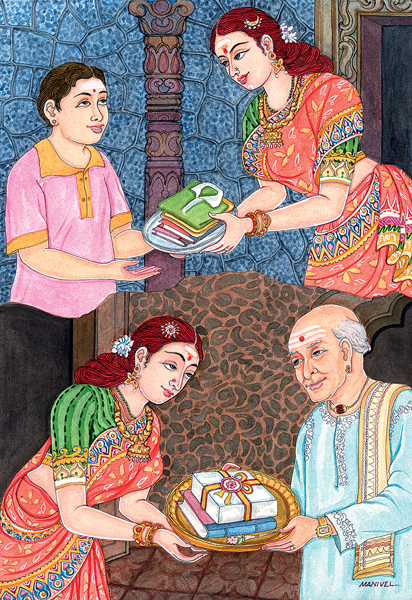|
Maitrayaniya Upanishad
The ''Maitrayaniya Upanishad'' (, ) is an ancient Sanskrit text that is embedded inside the Yajurveda.Paul Deussen, Sixty Upanishads of the Veda, Volume 1, Motilal Banarsidass, , pages 327-386 It is also known as the ''Maitri Upanishad'' (, ), and is listed as number 24 in the Muktika canon of 108 Upanishads. The ''Maitrayaniya Upanishad'' is associated with the ''Maitrayanas'' school of the Yajurveda. It is a part of the "black" Yajurveda, with the term "black" implying "the un-arranged, motley collection" of content in Yajurveda, in contrast to the "white" (well arranged) Yajurveda where Brihadaranyaka Upanishad and Isha Upanishad are embedded.Paul Deussen, Sixty Upanishads of the Veda, Volume 1, Motilal Banarsidass, , pages 217-219 The chronology of Maitrayaniya Upanishad is contested, but generally accepted to be a late period Upanishadic composition.Stephen Phillips (2009), Yoga, Karma, and Rebirth: A Brief History and Philosophy, Columbia University Press, , Chapter 1 ... [...More Info...] [...Related Items...] OR: [Wikipedia] [Google] [Baidu] |
1860s Manuscript Copy Of Ancient Maitrayaniya Upanishad, Sample Iii, Krishna Yajurveda, Pune Maharashtra, Sanskrit, Devanagari
Year 186 ( CLXXXVI) was a common year starting on Saturday of the Julian calendar. At the time, it was known as the Year of the Consulship of Aurelius and Glabrio (or, less frequently, year 939 ''Ab urbe condita''). The denomination 186 for this year has been used since the early medieval period, when the Anno Domini calendar era became the prevalent method in Europe for naming years. Events By place Roman Empire * Peasants in Gaul stage an anti-tax uprising under Maternus. * Roman governor Pertinax escapes an assassination attempt, by British usurpers. New Zealand * The Hatepe volcanic eruption extends Lake Taupō and makes skies red across the world. However, recent radiocarbon dating by R. Sparks has put the date at 233 AD ± 13 (95% confidence). Births * Ma Liang, Chinese official of the Shu Han state (d. 222) Deaths * April 21 – Apollonius the Apologist, Christian martyr * Bian Zhang, Chinese official and general (b. 133) * Paccia Marciana, Roman ... [...More Info...] [...Related Items...] OR: [Wikipedia] [Google] [Baidu] |
Prashna Upanishad
The Prashna Upanishad (, ) is an ancient Sanskrit text, embedded inside Atharva Veda, ascribed to ''Pippalada'' sakha of Vedic scholars. It is a Mukhya (primary) Upanishad, and is listed as number 4 in the Muktika canon of 108 Upanishads of Hinduism. The Prashna Upanishad contains six ''Prashna'' (questions), with each chapter discussing the answers.Robert HumePrasna Upanishad Thirteen Principal Upanishads, Oxford University Press, pages 378-390 The chapters end with the phrase, ''prasnaprativakanam'', which literally means, "thus ends the answer to the question". In some manuscripts discovered in India, the Upanishad is divided into three ''Adhyayas'' (chapters) with a total of six ''Kandikas'' (कण्डिका, short sections).Raksha BandhanRaksha BandhanBibliotheca Indica, Vol. XV, No. 41 and 50, Asiatic Society of Bengal, pages 119-141 The first three questions are profound metaphysical questions but, states Eduard Roer, do not contain any defined, philosophical answe ... [...More Info...] [...Related Items...] OR: [Wikipedia] [Google] [Baidu] |
Vedanta
''Vedanta'' (; , ), also known as ''Uttara Mīmāṃsā'', is one of the six orthodox (Āstika and nāstika, ''āstika'') traditions of Hindu philosophy and textual exegesis. The word ''Vedanta'' means 'conclusion of the Vedas', and encompasses the ideas that emerged from, or aligned and reinterpreted, the speculations and enumerations contained in the Upanishads, focusing, with varying emphasis, on devotion, knowledge and liberation. Vedanta developed into many traditions, all of which give their specific interpretations of a common group of texts called the ''Prasthanatrayi, Prasthānatrayī'', translated as 'the three sources': the ''Upanishads'', the ''Brahma Sutras'', and the ''Bhagavad Gita''. All Vedanta traditions are exegetical in nature, but also contain extensive discussions on ontology, soteriology, and epistemology, even as there is much disagreement among the various traditions. Independently considered, they may seem completely disparate due to the pronounced ... [...More Info...] [...Related Items...] OR: [Wikipedia] [Google] [Baidu] |
Ṛta
In the Historical Vedic religion, Vedic religion, ''Ṛta'' (International Phonetic Alphabet, /ɹ̩t̪ɐ/; Sanskrit ' "order, rhythm, rule; truth; logos") is the principle of natural order which regulates and coordinates the operation of the universe and everything within it. In the hymns of the Vedas, ''Ṛta'' is described as that which is ultimately responsible for the proper functioning of the natural, moral and sacrificial orders. Conceptually, it is closely allied to the injunctions and ordinances thought to uphold it, collectively referred to as ''Dharma'', and the action of the individual in relation to those ordinances, referred to as ''Karma'' – two terms which eventually eclipsed ''Ṛta'' in importance as signifying natural, religious and moral order in later Hinduism. Sanskrit scholar Maurice Bloomfield referred to ''Ṛta'' as "one of the most important religious conceptions of the Rigveda", going on to note that, "from the point of view of the history of religiou ... [...More Info...] [...Related Items...] OR: [Wikipedia] [Google] [Baidu] |
Guṇa
() is a concept in Hinduism, which can be translated as "quality, peculiarity, attribute, property".guna Monier Williams' Sanskrit-English Dictionary, Cologne Digital Sanskrit Lexicon, GermanyguNa Sanskrit-English Dictionary, Koeln University, Germany The concept is originally notable as a feature of Samkhya philosophy. The guṇas are now a key concept in nearly all schools of .James G. Lo ... [...More Info...] [...Related Items...] OR: [Wikipedia] [Google] [Baidu] |
Karma
Karma (, from , ; ) is an ancient Indian concept that refers to an action, work, or deed, and its effect or consequences. In Indian religions, the term more specifically refers to a principle of cause and effect, often descriptively called the principle of karma, wherein individuals' intent and actions (cause) influence their future (effect): Good intent and good deeds contribute to good karma and happier Reincarnation, rebirths, while bad intent and bad deeds contribute to bad karma and worse rebirths. In some scriptures, however, there is no link between rebirth and karma. In Hinduism, karma is traditionally classified into four types: Sanchita karma (accumulated karma from past actions across lifetimes), Prārabdha karma (a portion of Sanchita karma that is currently bearing fruit and determines the circumstances of the present life), Āgāmi karma (future karma generated by present actions), and Kriyamāṇa karma (immediate karma created by current actions, which may y ... [...More Info...] [...Related Items...] OR: [Wikipedia] [Google] [Baidu] |
Brihadratha Ikshvaku
Brihadratha, belonging to the Ikshvaku race, was a king of the Vedic era (there are several kings of this name in Hindu tradition). This name Brihadratha of a warrior king who was a Maharatha is found in the Rig Veda. The word, Brihadratha, means the Mighty Warrior. He appears at the beginning of the Maitri Upanishad after he had renounced his kingdom in favour of his son, seeking for himself relief from the endless cycle of birth and rebirth. No other information about him or his period is available in this text or in any other text. Maitri Upanishad belongs to the Maitrayaniya branch of Krishna Yajur Veda, which upanishad was taught to Sakayana by Maitri or Maitreya, the son of Mitra. Brihadratha chose the knowledge of the Self when he was offered a boon. He gave up his home and possessions and thereafter assisted by Sakayanya even renounced the “I-ness” of his body. Anti-Hedonism, evident in the Katha Upanishad The ''Katha Upanishad'' (, ), is an ancient Hindu tex ... [...More Info...] [...Related Items...] OR: [Wikipedia] [Google] [Baidu] |
Yajna
In Hinduism, ''Yajna'' or ''Yagna'' (, Help:IPA/Sanskrit, [jɐd͡ʒɲə], ) also known as Hawan, is a ritual done in front of a sacred fire, often with mantras. Yajna has been a Vedas, Vedic tradition, described in a layer of Vedic literature called Brahmanas, as well as Yajurveda. The tradition has evolved from offering oblations and libations into sacred fire to symbolic offerings in the presence of sacred fire (Agni). Yajna rituals-related texts have been called the ''Karma-kanda'' (ritual works) portion of the Vedic literature, in contrast to the ''Jnana-kanda'' (knowledge) portion found in the Vedic Upanishads. The proper completion of Yajna-like rituals was the focus of Mimansa school of Hindu philosophy. Yajna have continued to play a central role in a Hindu's rites of passage, such as weddings. Modern major Hindu temple ceremonies, Hindu community celebrations, or monastic initiations may also include Vedic Yajna rites, or alternatively be based on Āgama (Hinduism), A ... [...More Info...] [...Related Items...] OR: [Wikipedia] [Google] [Baidu] |
Moksha
''Moksha'' (; , '), also called ''vimoksha'', ''vimukti'', and ''mukti'', is a term in Jainism, Buddhism, Hinduism, and Sikhism for various forms of emancipation, liberation, '' nirvana'', or release. In its soteriological and eschatological senses, it refers to freedom from '' saṃsāra'', the cycle of death and rebirth. In its epistemological and psychological senses, ''moksha'' is freedom from ignorance: self-realization, self-actualization and self-knowledge. In Hindu traditions, ''moksha'' is a central concept and the utmost aim of human life; the other three aims are ''dharma'' (virtuous, proper, moral life), '' artha'' (material prosperity, income security, means of life), and '' kama'' (pleasure, sensuality, emotional fulfillment). Together, these four concepts are called Puruṣārtha in Hinduism. In some schools of Indian religions, ''moksha'' is considered equivalent to and used interchangeably with other terms such as ''vimoksha'', ''vimukti'', '' kaivalya'' ... [...More Info...] [...Related Items...] OR: [Wikipedia] [Google] [Baidu] |
Sannyasa
''Sannyasa'' (), sometimes spelled ''sanyasa'', is the fourth stage within the Hinduism, Hindu system of four life stages known as ''ashrama (stage), ashramas'', the first three being ''brahmacharya'' (celibate student), ''Gṛhastha, grihastha'' (householder) and ''Vānaprastha, vanaprastha'' (forest dweller, retired). ''Sannyasa'' is traditionally conceptualized for men or women in the last years of their life, but young ''brahmachari''s have the choice to skip the householder and retirement stages, renounce worldly and materialistic pursuits and dedicate their lives to spiritual pursuits. ''Sannyasa'', a form of asceticism marked by renunciation of material desires and prejudices, is characterized by a state of disinterest in and detachment from material life, with the purpose of spending one's life in peaceful, spiritual pursuits. An individual in Sanyasa is known as a ''sannyasi'' (male) or ''sannyasini'' (female) in Hinduism. Sannyasa shares similarities with the Sadhu a ... [...More Info...] [...Related Items...] OR: [Wikipedia] [Google] [Baidu] |
Brahmana
The Brahmanas (; Sanskrit: , International Alphabet of Sanskrit Transliteration, IAST: ''Brāhmaṇam'') are Vedas, Vedic śruti works attached to the Samhitas (hymns and mantras) of the Rigveda, Rig, Samaveda, Sama, Yajurveda, Yajur, and Atharvaveda, Atharva Vedas. They are a secondary layer or classification of Sanskrit texts embedded within each Veda, which explain and instruct on the performance of Yajna, Vedic rituals (in which the related Samhitas are recited). In addition to explaining the symbolism and meaning of the Samhitas, Brahmana literature also expounds scientific knowledge of the Vedic period, Vedic Period, including observational astronomy and, particularly in relation to altar construction, geometry. Divergent in nature, some Brahmanas also contain mystical and philosophical material that constitutes Aranyakas and Upanishads. Each Veda has one or more of its own Brahmanas, and each Brahmana is generally associated with a particular Shakha or Vedic school. Less ... [...More Info...] [...Related Items...] OR: [Wikipedia] [Google] [Baidu] |
Vaishnavism
Vaishnavism () ), also called Vishnuism, is one of the major Hindu denominations, Hindu traditions, that considers Vishnu as the sole Para Brahman, supreme being leading all other Hindu deities, that is, ''Mahavishnu''. It is one of the major Hindu denominations along with Shaivism, Shaktism, and Smartism. Its followers are called Vaishnavites or ''Vaishnava''s (), and it includes sub-sects like Krishnaism and Ramanandi Sampradaya, Ramaism, which consider Krishna and Rama as the supreme beings respectively. According to a 2020 estimate by The World Religion Database (WRD), hosted at Boston University’s Institute on Culture, Religion and World Affairs (CURA), Vaishnavism is the largest Hindu sect, constituting about 399 million Hindus. The ancient emergence of Vaishnavism is unclear, and broadly hypothesized as a History of Hinduism, fusion of various regional non-Vedic religions with worship of Vishnu. It is considered a merger of several popular non-Vedic theistic traditio ... [...More Info...] [...Related Items...] OR: [Wikipedia] [Google] [Baidu] |






